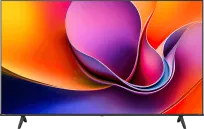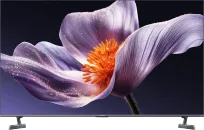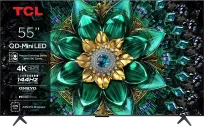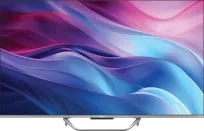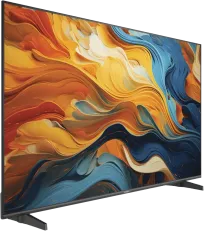
Today we are once again looking across the ocean (thanks to the editorial team at RTINGS) to see what's new with the Japanese giant. Sony is launching the Bravia 5 – a model that formally replaces the well-received X90L. At first glance, we get everything one would expect from a mid-range 'premium mid' TV: a VA panel, local dimming, 120 Hz, and a gaming package with Google TV on board.
But there's also something new – Mini LED backlighting replaces the traditional FALD zones known from the X90L. This is a change that could open the door to better contrast and dimming precision. The question is whether Sony has truly taken a step forward... or whether it has merely changed the label? How does the Bravia 5 compare to its predecessor – and does it have what it takes to compete with the increasingly better competition from China and Korea? Let's find out!
Appearance: Again, no surprises




“Designers' déjà vu” – that might be the best term for what Sony (and not just Sony) has given us in 2025. The Sony Bravia 5 looks almost identical to the two-year-old X90L. Slim bezels, the same minimalism, and really only the color might be slightly different... but frankly – as the author of this text, I must admit that the differences between “dark graphite” and “very dark gray” remain a mystery to me. Anyway – the effect at first glance is really the same.
But while not much has changed on the outside, the internal design decisions are a bit more surprising. The Bravia 5 has been slightly simplified compared to the X90L – this is evident in the stand. While the previous model allowed for the feet to be positioned wide or centrally, now we have only one option – the feet land in the middle. Fortunately, the possibility of raising them has not been removed, so a classic soundbar will easily fit under the screen.
Construction of the 98-inch version: thicker frames, greater stability?


In the end – although the television is not exceptionally slim and tends to maintain Sony's raw style, it can still be appealing. It is neat, without unnecessary embellishments, and the overall impression is that of a solid piece of equipment meant to last for years. It's also worth mentioning that, similar to the X90L, we cannot talk about "framelessness" in the largest 98-inch variant. In this size, the Japanese manufacturer decided to "stiffen" the construction by using thicker bezels. Does this result in better rigidity of the entire body? Perhaps – but it's good to keep this in mind when considering the largest model. Especially if someone also pays attention to the appearance of the device.
Contrast: Mini LED – more zones, but the same quality?
According to what Sony announced in promotional materials, and as RTINGS confirms in tests – the Bravia 5 has finally received the long-awaited change in backlighting. In the 65-inch variant, almost five times more dimming zones have been used compared to the X90L model, which was still based on classic FALD backlighting (it works like MINI-LED but has far fewer zones). This is great news – especially since the biggest problem with the X90L was the visible blooming effect, for example when displaying bright text on a dark background (in the gallery: comparison of X90L vs Bravia 7 with Mini LED, the picture speaks for itself).


Contrast: What Went Wrong?
And everything would be beautiful if it weren't for one "but." As we've mentioned before – just having the specifications is not enough for quality to come automatically. The way in which the manufacturer tunes the entire system also matters. And we're talking about Sony – a company that has proven time and again that it can extract maximum performance even from weaker hardware. This time, however... something went wrong. Despite having many more zones, the Bravia 5 achieves nearly the same contrast result as its predecessor. Differences? They exist but only in specific, laboratory scenarios. In everyday use, the television looks practically the same as the X90L. And that doesn't sound like a compliment. It's a shame because the potential was really significant; after all, we're talking about a full-fledged MINI-LED television.
Brightness and HDR – but what actually happened here?
Well then – since the contrast with the new Mini LED is practically the same as in its predecessor, maybe at least the brightness has been improved or is at the same level as on the X90L? Let’s remember: the previous model, according to our tests, could achieve around 1200 nits (HDR) in a 10% window, which was really great in this class, especially for movie fans.
And here... such a surprise. The Bravia 5, despite the newer backlighting technology, records a result around 700 nits. Yes, you read that correctly – not only is it not better, it's almost twice as dim as the model from 2023! What did Sony do? Why? How on earth? It’s hard to say. Because no documentation, no presentation, and no press release explains this result. Instead of evolution – a regression. Instead of a “wow” effect – a “why?!” effect. And all this in a television that was supposed to be an extension of the X90L concept, not its faded version.
Scaling and Image Processing – Sony Still Excels Here
Fortunately, there are things that Sony hasn't messed up. And even more – it still does them probably the best in the world. We're talking, of course, about image processing. The Bravia 5, just like its predecessor, uses the same tried-and-true "XR" image processor – and the effects are almost identical. Which means? Excellent.
Content of lower quality, such as classic television, YouTube, or Full HD materials, looks better than one might expect. Scaling works smoothly, cleanly, and without any artifacts. This is not, of course, any magic – the TV won’t conjure a reference-quality 4K image from an HD signal – but it does it well enough that you can forget how low quality the original was.
In this aspect, Bravia 5 still performs remarkably – and it’s still a reason to consider a Sony TV in this segment. Especially if someone watches a lot of online content or classic TV channels.
GoogleTV and eco remote


Just like its predecessor, the Bravia 5 runs on the Google TV system. This is good news; we have access to the largest number of applications on the market, so neither the hardware nor the manufacturer limits the user. Netflix, YouTube, HBO Max, Disney+, niche VODs, podcasts, and even television stations – everything is available from a single platform. Moreover, as is usually the case with Sony, we can expect that Google TV will operate exceptionally stably here. At least at the start – in the past, it was this brand of televisions that managed best with the "growing pains" of the new system, which could plague other models with Android.
The package also includes a new (or rather... familiar) remote control. Made from recycled materials, in line with the manufacturer's "eco-friendly philosophy," and devoid of classic numeric buttons. This is almost standard in new TVs – the minimalism that Samsung initiated a few years ago is now the norm. Is this a good direction? Hard to say. Some prefer simplicity because they only use the "up, down" arrows anyway, while others miss the classic layout with a full set of buttons.
Is it really "perfect for PS5"?
Sony has been promoting its TVs as "ideal for PS5" for several years now – and of course, the Bravia 5 is no exception. On paper, everything looks familiar and quite good: we have ALLM mode (that is, automatic switching to low latency mode), VRR technology, and two HDMI 2.1 ports that support 4K at 120 Hz. The panel itself also operates at 120 Hz – just like its predecessor, nothing has been compromised here 😉.
Additionally, Sony adds something extra – the PS Remote Play app, available only on their TVs. It allows you to connect to the PS5 console without physically plugging it into the TV – for example, from another room.
Unfortunately, not everything performs as well. As noted by the Rtings editorial team, the mode designed for gamers in the Bravia 5 exhibits quite a strong ghosting and blurring effect. This is not something we would like to see on a TV promoted as "gamer-friendly". We hope that Sony will respond and improve this aspect in updates...
Sony Bravia 5: the successor that forgot... to be better?




Bravia 5 is a television that in theory was supposed to be a natural development of the popular X90L. Sony added Mini LED, increased the number of dimming zones, kept a good processor, the Google TV system, and all features for gamers. Everything indicated that it would be better. And yet... it is not.
Contrast? Almost identical to its predecessor with a much smaller number of dimming zones. HDR brightness? A drop of nearly 40%. Game mode? Smearing and blurriness of the image that should not occur. And while the hardware of the Bravia 5 looks solid, the impression remains that Sony opted for minimal changes and hoped that no one would notice. Fortunately, there are elements that still do a great job – image processing, upscaling, interface fluidity, and Google TV applications are still the strong points of this brand. But in the context of the entire market offering – and the growing competition from TCL, Hisense, or Samsung – it's hard not to feel that the Bravia 5 is somewhat of a missed opportunity.
So if you are considering buying a Sony television, it’s worth checking out the sales of last year’s model, the X90L. According to the Rtings editorial team, it performs better than the Bravia 5 in almost all categories. An alternative could also be better model – Bravia 7, which at the time of writing this text costs almost the same as the Bravia 5, and in terms of image quality, it surpasses not only the Bravia 5 but also the X90L in many aspects.
(You will find a link to the comparison of the best Sony televisions below.)
Source: own elaboration, rtings.com
 Katarzyna Petru
Katarzyna Petru